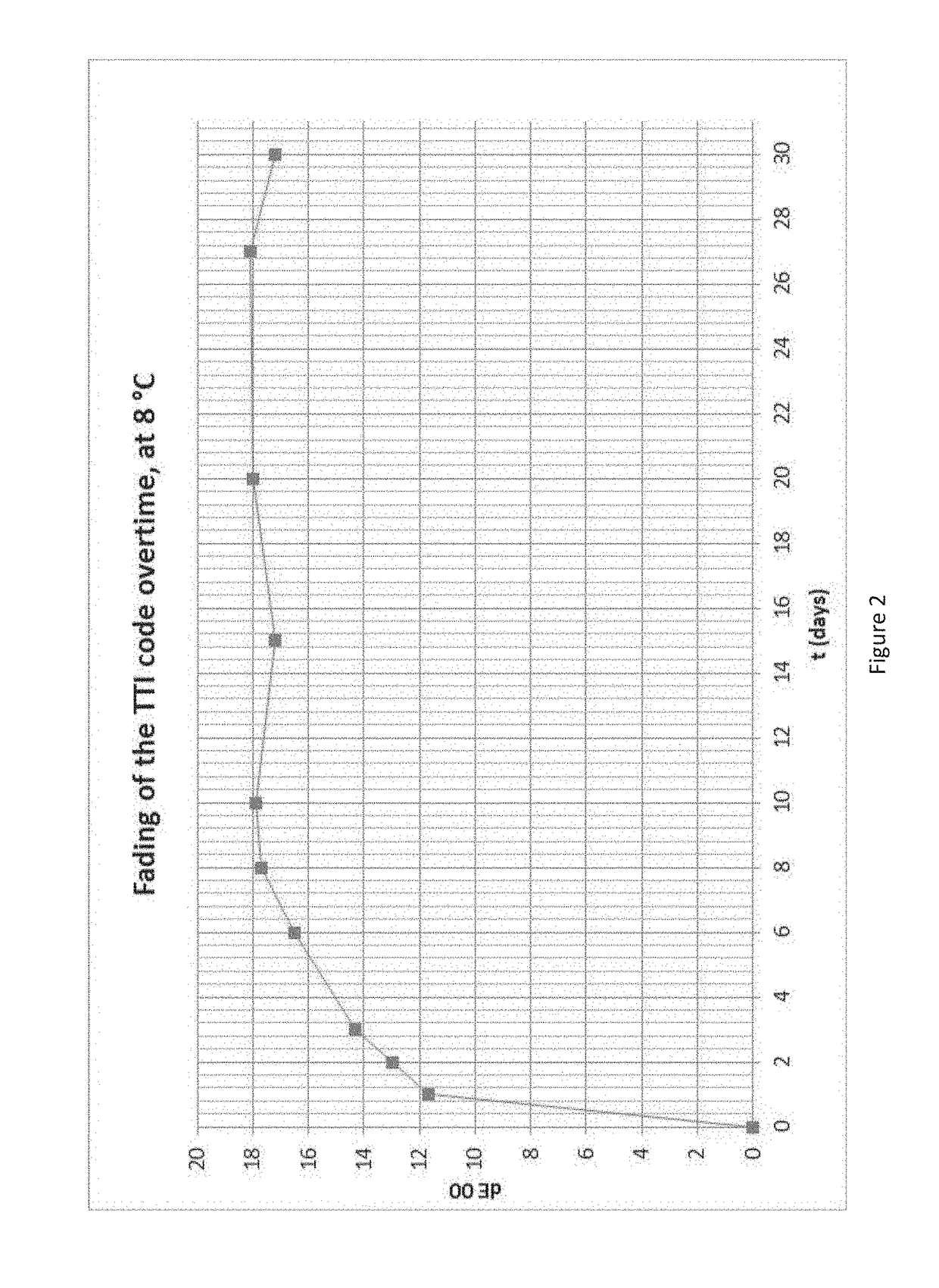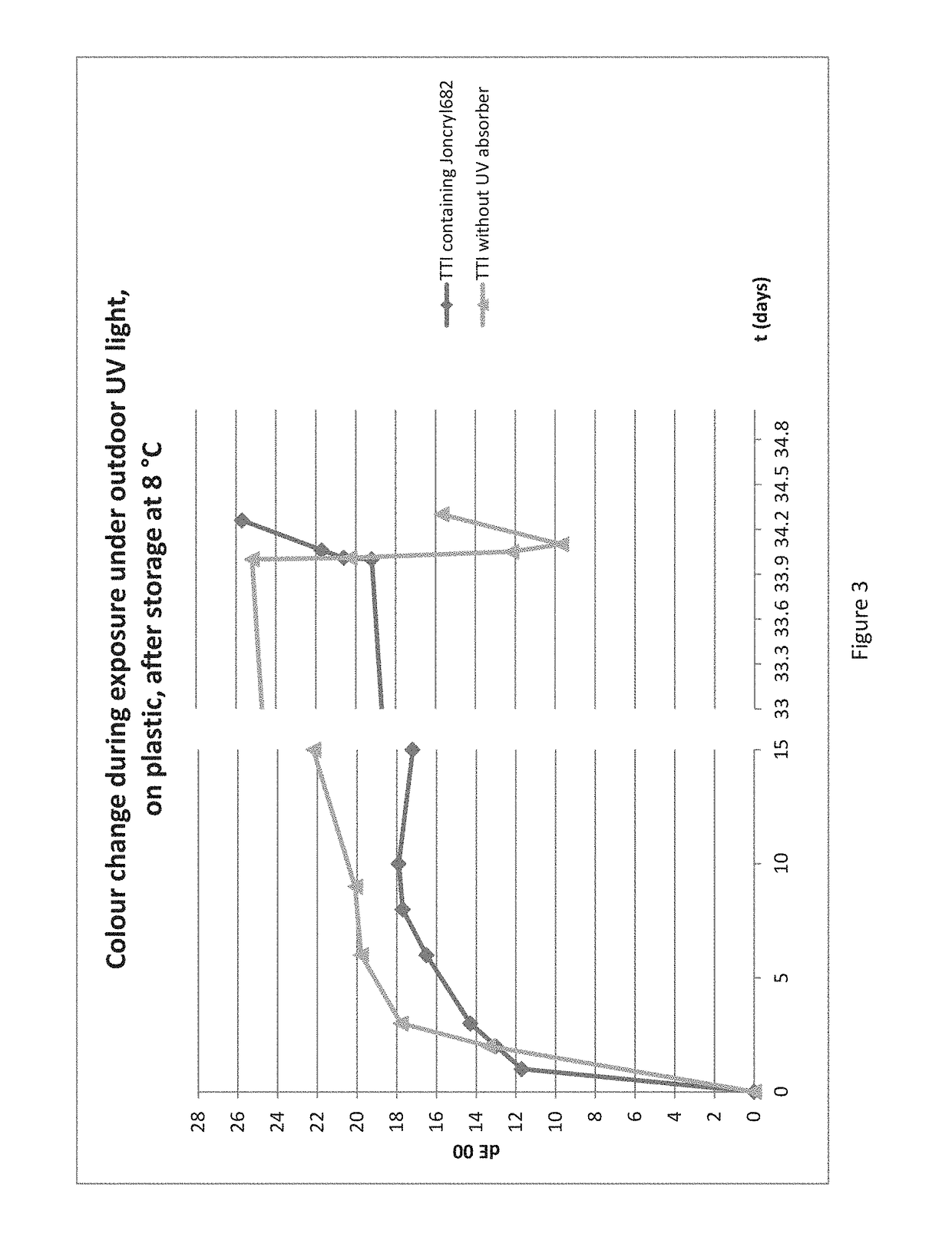Ink composition
- Summary
- Abstract
- Description
- Claims
- Application Information
AI Technical Summary
Benefits of technology
Problems solved by technology
Method used
Image
Examples
example 1
[0089]An ink comprising a photo-chromic colorant, 1,3,3-trimethylindolino-6′-nitrobenzopyrylospiran, was inkjet printed onto a substrate and activated by a 365 nm UV lamp at a distance of 20 mm from the substrate at an intensity of 2.25 W / cm2. The ink did not contain a UV absorber and so the colorant was not protected from UV light.
[0090]To assess the rate of fading of the ink, the colour co-ordinates of the ink were recorded by a spectroeye before activation by UV light, and at 0, 1, 2, 3, 5, 7, 9, 15, 20 and 30 days after activation. The ink was not subjected to UV or ambient light during this time and was kept at 8° C. The colour difference (ΔE) between the colour before activation and the colour at time “t” after activation was calculated using formula I:
ΔE00=√[(dL / SL′)2+(dC / SC′)2+(dH / SH′)2+RTdC′ / SC′dH′ / SH′] (Formula I)
[0091]The components of Formula I are calculated using the formulae below, disclosed in, for example, “Sharma, Gaurav; Wu, Wencheng; Dalal, Edul N. (2005).”The C...
example 2
[0094]The time-temperature indicator ink is prepared by addition of CAB-551-0.01 and Foralyn 110 as binders, TegoGlide 410 as additive, tert-butyl ammonium nitrate as salt, and Joncryl682 as UV absorber to the solvent butan-2-one. Once dissolved, 1,3,3-trimethylindolino-6′-nitrobenzopyrylospiran used as photochromic material was added to the solution. CAB-551-0.01, Foralyn 110, TegoGlide 410, tert-butyl ammonium nitrate, Joncryl682, butan-2-one and 1,3,3-trimethylindolino-6′-nitrobenzopyrylospiran are all commercially available. The mixture was left stirring for at least 2 hours, and then filtered through a GF / B (1.0 μm) filter. The quantity of each component is provided in Table 1.
TABLE 1MaterialQuantity (% wt)CAB-551-0.019TG4101TBAN2Foralyn 1101SP15JONCRYL 68210MEK72
[0095]The physical properties of the ink are shown in Table 2.
TABLE 2Conductivity (uS / cm)554-553Viscosity (cP)4.98-4.99Reflectance ratio (%)0.94Filtration time (s)26density (g / cm3)0.8807density (SG)0.8019
[0096]The ink ...
example 3
[0100]The performance of the ink of Example 2 was compared to an ink without a UV absorber therein. The photo-chromic colorant in the respective inks was 1,3,3-trimethylindolino-6′-nitrobenzopyrylospiran. The two inks were printed onto a plastic (polyethylene terephthalate (PET)) substrate and were tested on their resistance to being recharged under outdoor / ambient UV light. First, the respective inks were kept in the dark (i.e. no exposure to UV / ambient light) for 34 days at 8° C. During this time, the colour change from initial activation was recorded using a spectroeye. Both inks faded as the colorant molecule went from the photomerocyanine form to the colourless spiropyran form, i.e. the ink became deactivated.
[0101]After 34 days, the inks were exposed to ambient UV light. The colour coordinates of the inks were recorded with a spectroeye after 1, 5, 10 and 30 min of exposure to ambient UV light. The results are shown in Table 4 and plotted in FIG. 3.
[0102]Table 4 and FIG. 3 sh...
PUM
 Login to View More
Login to View More Abstract
Description
Claims
Application Information
 Login to View More
Login to View More - R&D
- Intellectual Property
- Life Sciences
- Materials
- Tech Scout
- Unparalleled Data Quality
- Higher Quality Content
- 60% Fewer Hallucinations
Browse by: Latest US Patents, China's latest patents, Technical Efficacy Thesaurus, Application Domain, Technology Topic, Popular Technical Reports.
© 2025 PatSnap. All rights reserved.Legal|Privacy policy|Modern Slavery Act Transparency Statement|Sitemap|About US| Contact US: help@patsnap.com



